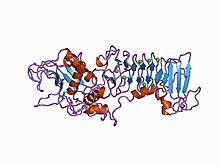
Back Metaloproteinaza BS Metalloproteasen German Metaloproteinasa Spanish متالوپروتئیناز Persian Métalloprotéinase French Metaloproteinase Galician מטאלופרוטאז HE Metaloprotease ID Metalloproteasi Italian 金属プロテアーゼ Japanese
| Peptidase_M48 | |||||||||
|---|---|---|---|---|---|---|---|---|---|
 | |||||||||
| Identifiers | |||||||||
| Symbol | Peptidase_M48 | ||||||||
| Pfam | PF01435 | ||||||||
| Pfam clan | CL0126 | ||||||||
| InterPro | IPR001915 | ||||||||
| MEROPS | M48 | ||||||||
| OPM superfamily | 394 | ||||||||
| OPM protein | 4aw6 | ||||||||
| Membranome | 317 | ||||||||
| |||||||||
| Peptidase_M50 | |||||||||
|---|---|---|---|---|---|---|---|---|---|
| Identifiers | |||||||||
| Symbol | Peptidase_M50 | ||||||||
| Pfam | PF02163 | ||||||||
| Pfam clan | CL0126 | ||||||||
| InterPro | IPR008915 | ||||||||
| MEROPS | M50 | ||||||||
| OPM superfamily | 184 | ||||||||
| OPM protein | 3b4r | ||||||||
| |||||||||
A metalloproteinase, or metalloprotease, is any protease enzyme whose catalytic mechanism involves a metal. An example is ADAM12 which plays a significant role in the fusion of muscle cells during embryo development, in a process known as myogenesis.
Most metalloproteases require zinc, but some use cobalt. The metal ion is coordinated to the protein via three ligands. The ligands coordinating the metal ion can vary with histidine, glutamate, aspartate, lysine, and arginine.[clarification needed] The fourth coordination position is taken up by a labile water molecule.
Treatment with chelating agents such as EDTA leads to complete inactivation. EDTA is a metal chelator that removes zinc, which is essential for activity. They are also inhibited by the chelator orthophenanthroline.